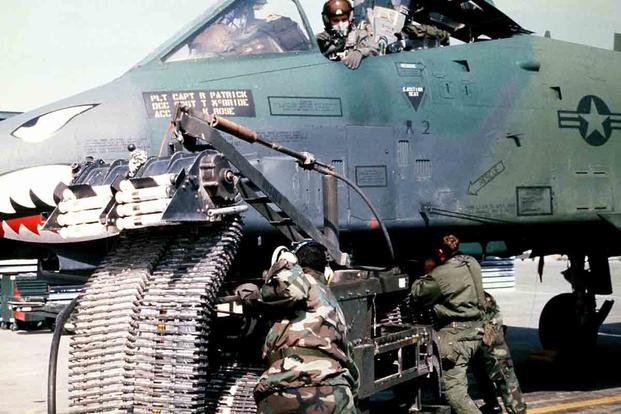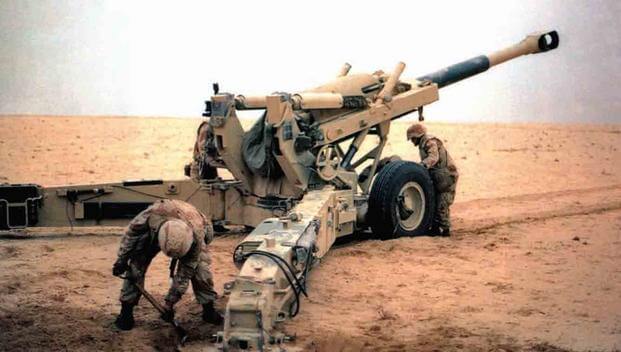Saddam Hussein was not the best military strategist. This is, after all, the guy who once said: "The air force has never decided a war." This quote came after he spent nearly a decade struggling not to be overrun by a weakened Iran in a war he started with a sucker punch.
When Hussein sent more than half a million troops into neighboring Kuwait on Aug. 2, 1990, he might have steamrolled over Kuwaiti defenders, but he proceeded to make a number of critical mistakes. One of them was an ill-fated invasion of Saudi Arabia, which might have worked, except for ...
Operation Desert Shield
The biggest mistake began with Hussein openly criticizing Saudi Arabia after capturing Kuwait. It was a move that made the world believe that it would be his next target, a threat the U.S. would not stomach. As laid out in the Carter Doctrine, the U.S. would use military force to preserve its interests in the region.
That meant oil. If the Iraqi Army invaded Saudi Arabia and the kingdom fell as fast as Kuwait did, which was roughly two days, Hussein would be in control of the majority of the world's known oil reserves. Understandably, the rest of the world wasn't thrilled with this idea.
Hussein annexed Kuwait, making it a province of Iraq and installing his cousin as governor. Then, he sat around, making his next mistake. He stayed put while the United States built up not only a coalition of 39 countries, but also nearly a million troops in Saudi Arabia and the surrounding water, along with the necessary armor, aircraft and equipment, during Operation Desert Shield.

By the time Iraq began to finally press its advantage by invading Saudi Arabia, there were 700,000 Americans stationed in Saudi Arabia, along with scores of other coalition troops. Hussein believed he had a trump card against the coalition, however: If he could lure its forces into one major battle, he could inflict enough casualties to make the U.S. back down, even if he didn't win that battle.
He even came to believe the United States wouldn't fight.
Operation Desert Storm
Operation Desert Shield had progressed to Operation Desert Storm on Jan. 17, 1991. Desert Storm began with a massive air campaign that was wrecking Iraqi targets throughout the region at the rate of 1,000 sorties per day.

Coalition forces established air superiority on day one, with what remained of Iraq's air force escaping to Iran. Its plan was then to target Republican Guard units and Scud missile batteries before turning its focus to the Iraqis in Kuwait, but Saddam Hussein threw a very small wrench in that plan.
The first major ground battle of the Gulf War was unexpectedly initiated by the Iraqi Army. On the night of Jan. 29, 1991, Hussein sent three of his best armored divisions across the border into Saudi Arabia. He'd hoped to give the coalition a bloody nose as the world watched live on CNN and fracture the coalition that was set to push him out of Kuwait.
They were headed for the near-abandoned coastal city of Khafji, the road to which was defended by only one Saudi National Guard Brigade. Iraq managed to surprise coalition commanders only because they were preoccupied with the ongoing air campaign.
It was 12 days in to what would become a 42-day aerial bombing campaign against Iraq by coalition airpower. Air Force planners believed Iraq was hoping to take advantage of the darkness so it could maneuver its forces with minimal resistance from the ongoing air campaign.

Hussein also chose Khafji because it had two harbors, one for oil exports and one from which he could threaten coalition naval forces in the Persian Gulf. It was also within range of Iraqi artillery batteries in Kuwait. If he captured a Saudi town, the Saudis would be forced to respond, and Saddam would get his chance at one grand battle.
The Mother of All Battles
During Operation Desert Shield, the coalition established a series of observation posts, 10 to 20 kilometers apart, manned by Navy SEALs, Army Special Forces and Marine Corps reconnaissance teams in order to keep watch on Iraqi movements across the Kuwaiti border.
Three of these posts could support operations along the road into Khafji, but only the 2nd Saudi Arabian National Guard (SANG) Brigade and an attached Qatari armored battalion were responsible for the defense of the town.
The Iraqi 6th Armored Brigade encountered its first coalition resistance as it ran into Observation Post 4 (OP-4), manned by a Marine Corps company of light infantry, armed with Light Armored Vehicles and TOW-2 anti-tank missiles. A company of Marines, though outnumbered against a brigade, stalled the advance with help from coalition airpower, specifically A-10 Thunderbolt IIs.

As the fighting raged at OP-4, the rest of the massed Iraqi divisions advanced on Khafji. The Iraqi 5th Mechanized Division crossed the border near another observation post, OP-1, but was attacked by allied airpower in the form of A-10s, Harriers and F-16 Fighting Falcons. When the Iraqis tried slipping by OP-2, they also met heavy air resistance. Both units would retreat across the border.
Finally, an Iraqi column crossed the Saudi Arabian border and headed down the coastal road toward Khafji. This force was engaged by the 2nd Saudi Arabian National Guard Brigade, which cut off contact after taking heavy fire from the Iraqis. AC-130 gunships pounded two columns of Iraqi tanks along the road, but it wasn't enough.
Khafji fell to the Iraqis after midnight on Jan. 30, but coalition airpower was showing how effective it could be against even the largest of ground offensives.
Hussein was correct about the Saudi response to the occupation of their city. The kingdom asked Gen. Norman Schwarzkopf to launch an immediate counterattack, but Schwarzkopf wasn't going to play Saddam's game. He decided the Saudis were going to retake their own city with the help of Recon Marines, Marine artillery and Army Special Forces.
Qatari forces cut off the Iraqi advance to the south of Khafji while Saudi National Guard units and coalition air forces cut off reinforcements to the north. Marine Corps artillery pounded the city on Jan. 30, with the help of a six-man Marine reconnaissance team that stayed behind inside the occupied city. Meanwhile, coalition aircraft wreaked havoc on the Iraqis.

On the morning of Jan. 31, three battalions of Saudi infantry launched an assault to retake Khafji. Iraq was cut off from reinforcements and could neither retreat nor advance. The Iraqis were sitting ducks as the Arab forces cleared buildings in the city, moving north from Khafji's south.
As the sun rose on Feb. 1, 1991, Saudi infantry was advancing through Khafji with light resistance. Some Iraqi holdouts lasted a little bit longer, but the burnt-out remains of Iraqi artillery, armored vehicles and hollow shells that used to be tanks told the tale.
The fierce fighting in Hussein's attempt at a "Mother of All Battles" left 11 U.S. Marines and 14 airmen dead, three wounded Americans and two U.S. prisoners of war captured by the Iraqis. The U.S. also lost two light armored vehicles and one AC-130 gunship. The Arab armies at Khafji suffered 18 dead and 50 wounded.
Iraq lost three of its best mechanized divisions, all of which were destroyed, along with more than a thousand killed, wounded or missing in action. Both the Saudis and Iraqis claimed it as a propaganda victory, but it was more of a training mission for the coalition, which now knew exactly what to expect when expelling Iraq from Kuwait.
On Feb. 24, coalition ground forces began the liberation of Kuwait with a 90,000-round artillery barrage. Just 100 hours later, Iraq was defeated, Kuwait's emir was back in power and a cease-fire went into effect.
-- Blake Stilwell can be reached at blake.stilwell@military.com. He can also be found on Twitter @blakestilwell or on Facebook.
Want to Learn More About Military Life?
Whether you're thinking of joining the military, looking for post-military careers or keeping up with military life and benefits, Military.com has you covered. Subscribe to Military.com to have military news, updates and resources delivered directly to your inbox.












